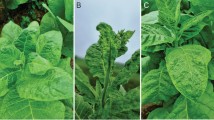Abstract
We determined the complete genome sequence of a new virus infecting Ecballium elaterium (‘cohombrillo amargo’) plants, a weed species common on the borders of cultivated fields in the Mediterranean region. The genome of this virus is composed of two molecules of monocistronic positive-sense RNA, 6,934 and 3,501 nucleotides in length, excluding their poly(A) tails. The highest amino acid sequence similarity (50 % identity) in the Pro-Pol core region encoded by RNA 1 was observed in the corresponding protein of strawberry latent ringspot virus. Based on pairwise comparisons and phylogenetic analysis, this virus, tentatively named "cohombrillo-associated virus" (CoAV), appears to be a member of a new species in the genus Stralarivirus (family Secoviridae), for which the name “Stralarivirus elaterii” is proposed. This new virus has different putative cleavage patterns from members of other species belonging to this genus.


Similar content being viewed by others
Data availability
Author state that the sequences corresponding to RNA1 and RNA2 of CoAV have been submitted to the GenBank database under the accession numbers: OP019481 and OP019482, respectively. They will be available online as soon as possible. The sequences are also available in Supplemental file 1.
References
Sanfaçon H, Wellink J, Le Gall O, Karasev A, Van der Vlugt R, Wetzel T (2009) Secoviridae: a proposed family of plant viruses within the order Picornavirales that combines the families Sequiviridae and Comoviridae, the unassigned genera Cheravirus and Sadwavirus, and the proposed genus Torradovirus. Arch Virol 154:899–907
King AMQ, Lefkowitz E, Adams MJ, Carstens EB (2011) Virus taxonomy: ninth report of the International Committee on Taxonomy of Viruses. Elsevier, Oxford
Dullemans AM, Botermans M, de Kock MJD et al (2020) Creation of a new genus in the family Secoviridae substantiated by sequence variation of newly identified strawberry latent ringspot virus isolates. Arch Virol 165:21–31. https://doi.org/10.1007/s00705-019-04437-0
Thompson JR, Dasgupta I, Fuchs M et al (2017) ICTV virus taxonomy profile: Secoviridae. J Gen Virol 98:529
Maachi A, Donaire L, Hernando Y, Aranda MA (2022) Genetic differentiation and migration fluxes of viruses from melon crops and crop edge weeds. J Virol 96:e00421-e422. https://doi.org/10.1128/jvi.00421-22
Koonin EV, Mushegian AR, Ryabov EV, Dolja VV (1991) Diverse groups of plant RNA and DNA viruses share related movement proteins that may possess chaperone-like activity. J Gen Virol 72:2895–2903. https://doi.org/10.1099/0022-1317-72-12-2895
Lefort V, Longueville J-E, Gascuel O (2017) SMS: smart model selection in PhyML. Mol Biol Evol 34:2422–2424. https://doi.org/10.1093/molbev/msx149
Guindon S, Dufayard J-F, Lefort V, Anisimova M, Hordijk W, Gascuel O (2010) New algorithms and methods to estimate maximum-likelihood phylogenies: assessing the performance of PhyML 3.0. Syst Biol 59:307–321. https://doi.org/10.1093/sysbio/syq010
Acknowledgements
We would like to express our deepest thanks to Hélène Sanfaçon (Summerland Research and Development Centre, Agriculture and Agri-Food Canada, British Columbia, Canada) for the stimulating discussion, for helping us to predict the amino acid at the substrate binding pocket site of the protease, and for her constant feedback on the prediction of the polyprotein cleavage sites. We want also to thank Mario Fon (mariogfon@gmail.com) for editing the final version of manuscript.
Funding
This article was funded by the European Union's Horizon 2020 research and innovation program under the Marie Sklodowska-Curie Grant Agreement No., 813542T.
Author information
Authors and Affiliations
Contributions
Conceptualization: AM, MAA, and LD. Experiments and analysis: AM. Writing: AM. Writing—review and editing: AM, MAA, and LD. Funding acquisition: YH.
Corresponding author
Ethics declarations
Conflict of interest
The authors declare that they have no conflict of interest.
Additional information
Handling Editor: Sead Sabanadzovic.
Publisher's Note
Springer Nature remains neutral with regard to jurisdictional claims in published maps and institutional affiliations.
Supplementary Information
Below is the link to the electronic supplementary material.
Rights and permissions
Springer Nature or its licensor (e.g. a society or other partner) holds exclusive rights to this article under a publishing agreement with the author(s) or other rightsholder(s); author self-archiving of the accepted manuscript version of this article is solely governed by the terms of such publishing agreement and applicable law.
About this article
Cite this article
Maachi, A., Hernando, Y., Aranda, M.A. et al. Cohombrillo-associated virus: a novel virus infecting Ecballium elaterium plants. Arch Virol 168, 16 (2023). https://doi.org/10.1007/s00705-022-05669-3
Received:
Accepted:
Published:
DOI: https://doi.org/10.1007/s00705-022-05669-3




